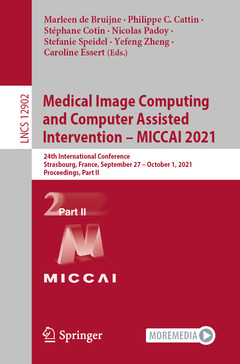Medical Image Computing and Computer Assisted Intervention – MICCAI 2021, 1st ed. 2021 24th International Conference, Strasbourg, France, September 27–October 1, 2021, Proceedings, Part II Image Processing, Computer Vision, Pattern Recognition, and Graphics Series
Coordonnateurs : de Bruijne Marleen, Cattin Philippe C., Cotin Stéphane, Padoy Nicolas, Speidel Stefanie, Zheng Yefeng, Essert Caroline

The 531 revised full papers presented were carefully reviewed and selected from 1630 submissions in a double-blind review process. The papers are organized in the following topical sections:
Part I: image segmentation
Part II: machine learning - self-supervised learning; machine learning - semi-supervised learning; and machine learning - weakly supervised learning
Part III: machine learning - advances in machine learning theory; machine learning - attention models; machine learning - domain adaptation; machine learning - federated learning; machine learning - interpretability / explainability; and machine learning - uncertainty
Part IV: image registration; image-guided interventions and surgery; surgical data science; surgical planning and simulation; surgical skill and work flow analysis; and surgical visualization and mixed, augmented and virtual reality
Part V: computer aided diagnosis; integration of imaging with non-imaging biomarkers; and outcome/disease prediction
Part VI: image reconstruction; clinical applications - cardiac; and clinical applications - vascular
Part VII: clinical applications - abdomen; clinical applications - breast; clinical applications - dermatology; clinical applications - fetal imaging; clinical applications - lung; clinical applications - neuroimaging - brain development; clinical applications - neuroimaging - DWI and tractography; clinical applications - neuroimaging - functional brain networks; clinical applications - neuroimaging ? others; and clinical applications - oncology
Part VIII: clinical applications - ophthalmology; computational (integrative) pathology; modalities - microscopy; modalities - histopathology; and modalities - ultrasound
*The conference was held virtually.
Date de parution : 09-2021
Ouvrage de 662 p.
15.5x23.5 cm
Thème de Medical Image Computing and Computer Assisted... :
Mots-clés :
artificial intelligence; bioinformatics; computer aided diagnosis; computer assisted interventions; computer vision; data mining; image analysis; image matching; image processing; image quality; image reconstruction; image segmentation; imaging systems; machine learning; medical images; neural networks; object recognition; pattern recognition; segmentation methods



